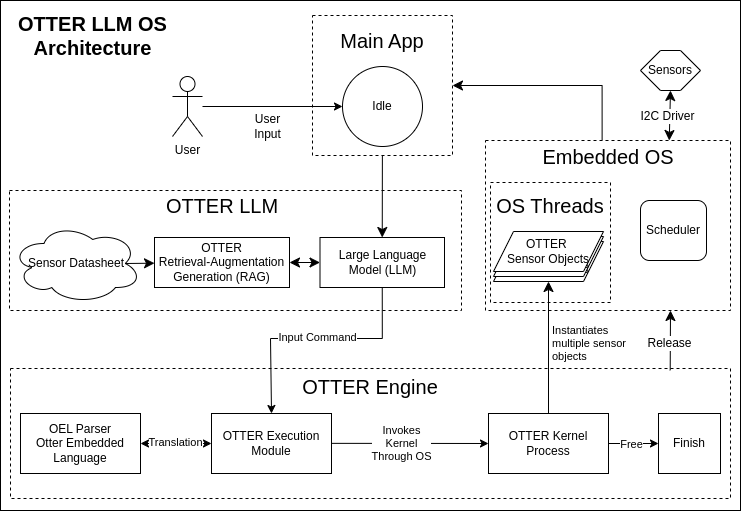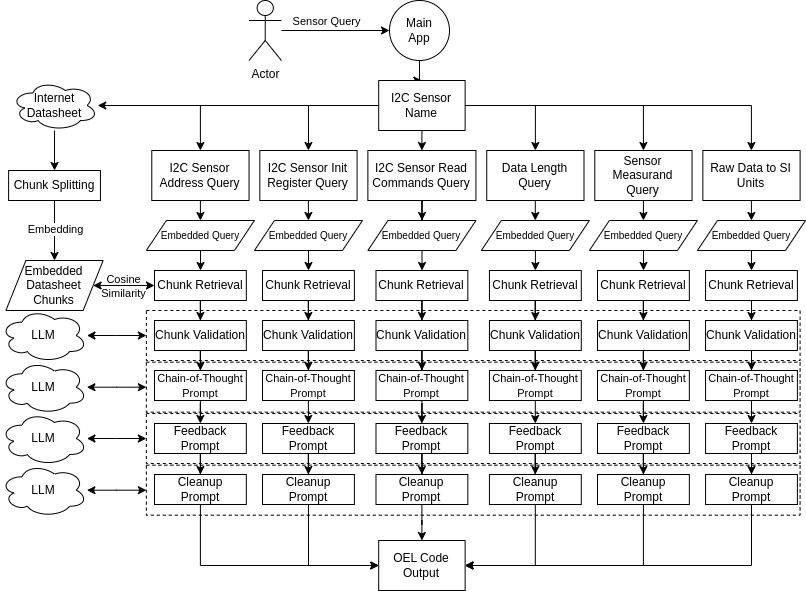OTTER LLM OS
Github Link: https://github.com/stevenantya/LLM-OS-OTTER/
Paper Link: Dissertation
Overview

OTTER LLM OS is a novel embedded operating system that leverages Large Language Models (LLMs) and retrieval-augmented generation (RAG) to enable prompt-driven, runtime i2 c sensor interface. OTTER OS integrates an intelligent LLM pipeline for datasheet parsing, a domain-specific intermediate language (OTTER Embedded Language or OEL), and a multithreaded execution engine (OTTER Engine) built on Mbed OS to dynamically instantiate sensor threads from natural language commands. The system supports plug-and-play functionality, multiple concurrent sensors, and reading of i2 c data in physical measurements, all without requiring manual code updates or recompilation. Experimental results show that OTTER OS achieves an 80.5% success rate in end-to-end sensor interfacing and 94.9% accuracy in context validation. OTTER OS’s modular architecture and runtime adaptability demonstrate a new paradigm in embedded sensor interfacing, bridging AI-driven reasoning with low-level hardware control to reduce development time, improve flexibility, and democratize sensor access for non-experts.
Features
- LLM-Powered Sensor Configuration: Converts natural language descriptions into optimized sensor configurations.
- Dynamic I2C Communication: Enables flexible interfacing with multiple sensors without hardcoded implementations.
- OTTER Embedded Language (OEL): A proprietary language that enhances computational efficiency and enables real-time sensor data processing.
- Kernel Process for Multi-Sensor Management: Handles multiple I/O operations seamlessly, ensuring efficient data acquisition and processing.
- Scalable and Modular: Supports various embedded platforms including Arduino, ESP32, and Linux-based SBCs.
- Proprietary Sensor Definition Language: Defines data formats and scaling transformations for streamlined sensor integration.
OTTER LLM

Workflow
- User Input: Provide a natural language description of the sensor setup.
- LLM Processing: The model interprets and translates the input into OEL.
- OEL Execution: OTTER OS parses and executes OEL to configure sensors dynamically.
- Kernel Process Management: Manages multi-sensor I2C communication efficiently.
- Data Retrieval & Processing: Fetches, formats, and scales sensor data based on predefined rules.
Tested Hardware
- Microcontrollers: Arduino Nano 33 BLE Sense Lite.
- Sensors:
- Temperature Sensors: MCP9808, TMP102
- Temperature & Humidity Sensors: AHT20, SHT31
- Altitude/Pressure Sensors: MPL3115A2, GY-BMP280
- Time of Flight Sensor: IRS11A 0J9776